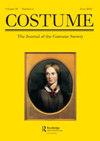The Decline of Female Mourning Wear: A Case Study Analysis of Frederic Forster's Mourning Warehouse 1849–1923 in Leeds, UK
IF 0.3
4区 社会学
0 HUMANITIES, MULTIDISCIPLINARY
引用次数: 0
Abstract
This article discusses substantial new research which explored the trade in UK female mourning wear by tracing the history of Frederic Forster’s Mourning Warehouse, situated on Lower Briggate in Leeds 1849–1923. It also interrogated the small collection of Forster items held by Leeds Museums and Galleries (LMG). This helped to develop an understanding of why UK female mourning wear, which dominated the High Street in the late nineteenth century, began to diminish. The research subsequently examined what the Forster items signify to a present-day audience and whether the need for special clothing to denote mourning has decreased or is met by other clothing practices in a globalized world. A review of literature raised several explanations, suggesting that the cultural work done by mourning clothing is no longer required today and the symbolic efficacy of black mourning clothing disappeared as black became increasingly popular in fashionable dress. The study tested these suppositions through an object-based analysis of the items in the LMG collection and a database search of newspaper advertisements from Frederic Forster in the period 1849–1923. The research activities were filmed to synthesize the insights and the film was discussed with a selection of interview participants to explore significant new knowledge and understanding about the decline of the UK female mourning dress trade.女性丧服的衰落——以弗雷德里克·福斯特1849-1923年英国利兹的丧服仓库为例
本文通过追溯1849年至1923年位于利兹下布里盖特的弗雷德里克·福斯特的哀悼仓库的历史,讨论了大量新的研究,这些研究探索了英国女性丧服的贸易。它还询问了利兹博物馆和画廊(LMG)持有的福斯特物品的小收藏。这有助于理解为什么英国女性的丧服在19世纪后期主导了高街,开始减少。该研究随后调查了福斯特的物品对当今观众意味着什么,以及在全球化的世界中,对表示哀悼的特殊服装的需求是否已经减少或被其他服装实践所满足。对文献的回顾提出了几种解释,认为今天不再需要丧服所做的文化工作,随着黑色在时装中越来越流行,黑色丧服的象征功效也消失了。该研究通过对LMG收藏中的物品进行基于对象的分析,以及对弗雷德里克·福斯特1849-1923年期间的报纸广告进行数据库搜索,来验证这些假设。研究活动被拍摄以综合见解,并与选定的访谈参与者讨论电影,以探索有关英国女性丧服贸易衰落的重要新知识和理解。
本文章由计算机程序翻译,如有差异,请以英文原文为准。
求助全文
约1分钟内获得全文
求助全文
来源期刊

Costume-The Journal of the Costume Society
HUMANITIES, MULTIDISCIPLINARY-
CiteScore
0.40
自引率
50.00%
发文量
27
期刊介绍:
Costume is the journal of the Costume Society. It is a scholarly, refereed, academic publication presenting current research into historic and contemporary dress. The journal publishes articles primarily object-based, from a broad chronological period and with a worldwide remit. Costume maintains a balance between practice and theory and concentrates on the social significance of dress. Articles are welcomed from established researchers and those new to the field. The articles published in Costume are sent out for peer-review to ensure that they are of a high standard and make a contribution to dress history.
 求助内容:
求助内容: 应助结果提醒方式:
应助结果提醒方式:


